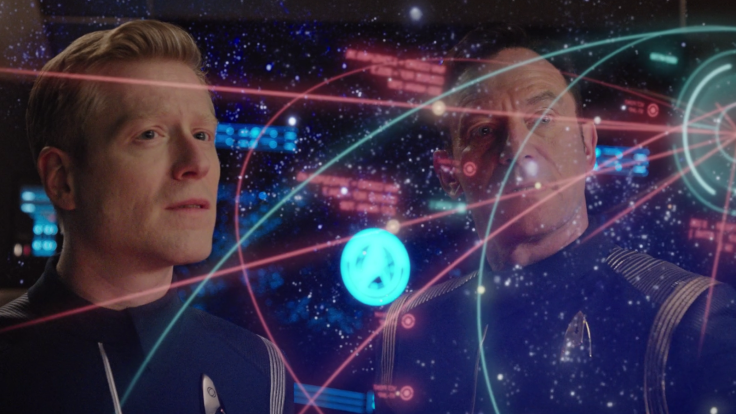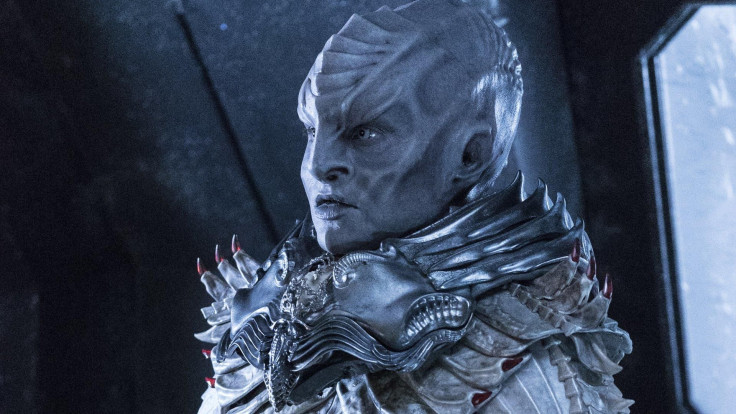By the end of Star Trek: Discovery’s midseason finale, “Into the Forest I Go,” the Klingon Ship of the Dead has been destroyed with Klingon warlord Kol aboard. Captain Lorca is now a hero, despite his insubordination (and increasing paranoia and sociopathy). The war isn’t over, but it’s very nearly been won. But while the episode is first about victory, its individual tragedies are likely to be more consequential when Star Trek: Discovery returns in January 2018.
After surviving 133 spore jumps, Stamets (Anthony Rapp) tries one last jump to get Discovery home. But Lorca sabotages the jump (or so it seems), beaming the ship to a mysterious and uncharted place, presumably the Mirror universe introduced in Star Trek: The Original Series — a land of goatees and evil twins. And if that wasn’t bad enough, it looks like Stamets has caught a bad case of Gary Mitchell eyes. It’s not yet certain he’ll have the same god-like powers Mitchell developed in Original Series episode “Where No Man Has Gone Before,” but there’s a strong possibility Stamets will represent an immediate threat to Discovery and her crew when the series returns with its next episode, “Despite Yourself.”

But while Stamets’ transformation in “Into the Forest I Go” sets up the clearest threat, it’s Ash Tyler’s (Shazad Latif) reunion with his Klingon torturer, L’Rell, that promises both further exploration of trauma and identity — two of Discovery’s core themes — and major shakeups within the cast and the series’ serial narrative.
Tyler suffers from PTSD, brought on by the torture he suffered while in Klingon captivity, and the guilt and shame he carries for submitting to L’Rell’s sexual advances to save himself from the fate of most Klingon prisoners: being tortured to death. Here Discovery is taking Star Trek into genuinely new and unexplored moral territory for the series.
Sexual abuse is staggeringly ubiquitous in our society, left largely unspoken and unreported. The surge of abusers exposed in politics and entertainment is just the beginning of a civilizational reckoning we shouldn’t look away from (a reckoning particularly overdue in the military). That Discovery extends compassion and explores the trauma of a male victim who “consented” to his assault is remarkable in itself, particularly since Tyler’s strength and competency as a soldier defies typical victim-blaming narratives — “Why didn’t he fight back? Did he bring this on himself?” is as starkly repulsive here as it should be in the real world.
But there’s an extra complication with Tyler that makes his sexual assault a stranger narrative event than a clearheaded stance on a societal issue: he’s probably not a victim at all. It seems even more certain after the events of “Into the Forest I Go” that Tyler is a Klingon in disguise.
Though consistently reported as a “fan theory” that deposed Klingon leader Voq had himself surgically altered and embedded aboard the Discovery in a human guise, it’s really more of an inevitable extrapolation from the numerous hints Discovery has so far provided. This ain’t exactly the most well-hidden twist in TV history. Very briefly, the evidence:
- L’Rell sent Voq away to the House of Mo’Kai, “weavers of lies,” who are experts in espionage, warning him that he’d have to give up “everything” to achieve victory.
- The very next episode Lorca and Tyler easily escape L’Rell’s imprisonment after Lorca voices suspicion about how Tyler survived his Klingon tortures.
- We witness Tyler’s “torture” in flashback, though the images could also depict painful surgery.
- Klingons losing their ethnic and cultural identity in the face of Starfleet homogeneity is a central theme.
- Klingons have disguised themselves as human in other Star Trek episodes.
- At the end of “Into the Forest I Go,” L’Rell as much as tells Tyler that she’d soon reveal his true identity to him.
So, Tyler the Klingon spy isn’t so much a fan theory as the text of what’s happening. Unless Star Trek: Discovery is smart enough to bluff a big twist, Tyler will eventually be revealed as having not suffered sexual assault at all.
For now, it’s mostly working and Star Trek: Discovery is successfully having it both ways. “Into the Forest I Go” smartly proves Tyler is unaware of his true Klingon nature. He’s been brainwashed, his true personality fully buried within a very troubled human. For Tyler as he’s currently constituted, the trauma is not feigned, but very real. Still, there’s also something cynically instrumental in knowing his trauma will be undermined, similar to the sickly feeling I got when Tyler’s PTSD flared just in time for it to prove convenient for the plot, allowing Michael Burnham the space to be the hero. Star Trek: Discovery is playing a dangerous game, intermingling its serial plot widgets with complicated and traumatic real-world issues.
Nowhere is this challenging and sometimes clumsily executed complexity more confusing, strange, exploitative and fascinating than in Tyler’s graphic flashback to sex with L’Rell. While feelings have been mixed on Discovery’s sometimes extreme violence (I am always in favor of extreme violence) and use of the word “fuck” (I am also always in favor of the word “fuck”), it’s DSC’s sex scene that’s most likely to be infamous with fans.
If Tyler is a traumatized human, it’s a queasy depiction of sexual assault. But if Tyler is Klingon, it’s something altogether different. The latest episode of Star Trek: Discovery didn’t just feature the most graphic sex scene in the franchise’s 51-year history, but hurdled right into an alien ambiguity of desire, lust and violence unlike anything since Andrzej Zulawski’s 1981 horror-drama, Possession, about both the dissolution of a marriage and an affair with a slimy monster that must be protected from humans at all costs.
It’s not just Possession either, Tyler’s trauma in “Into the Forest I Go” mirrors a number of other body horror movies, from The Fly to Tetsuo: The Iron Man. When we’ve previously met Klingons transformed into humans, such as in “The Trouble with Tribbles,” there’s never been a hint of the suffering undergone to induce that transformation. If we are witnessing flashbacks to Voq’s surgery, it suggests something far more physical and violently transformative than whatever genetic science hoo-ha we probably imagined.
Tyler now finds himself in a zone of subjectivity familiar to Anna and other body horror protagonists — where the plasticity of his form conflicts with an identity he believed to be firm — something he recognizes as more than suppressed trauma. “What did you do to me?” he asks L’Rell, kneeling before her cell in the ship’s brig, compelled somehow to confront her alone in the middle of the night. Were his memories altered, perverting a consensual experience between two Klingons into a torturous one? Or was he first transformed and assaulted, already believing himself to be human? While his flashbacks play up the alienness of the naked Klingon body, does he feel an inexplicable attraction for which only L’Rell and the viewers know the answer? His memories unreliable, his emotions confused, Tyler is both reliving trauma and approaching a transformation that could invert his suffering, or leave him more torn than ever.
However it shakes out in the second half of Star Trek: Discovery’s first season, the show has already entered an unfamiliar place, unlike anything Star Trek has done before.
- Richly redesigned Klingons
- Complex and explicable motives
- Great new Starfleet characters
- Incredible production design
- Generic space combat and action
- Too many flashbacks
- Eschews subtext, doesn't put enough faith in the audience



















